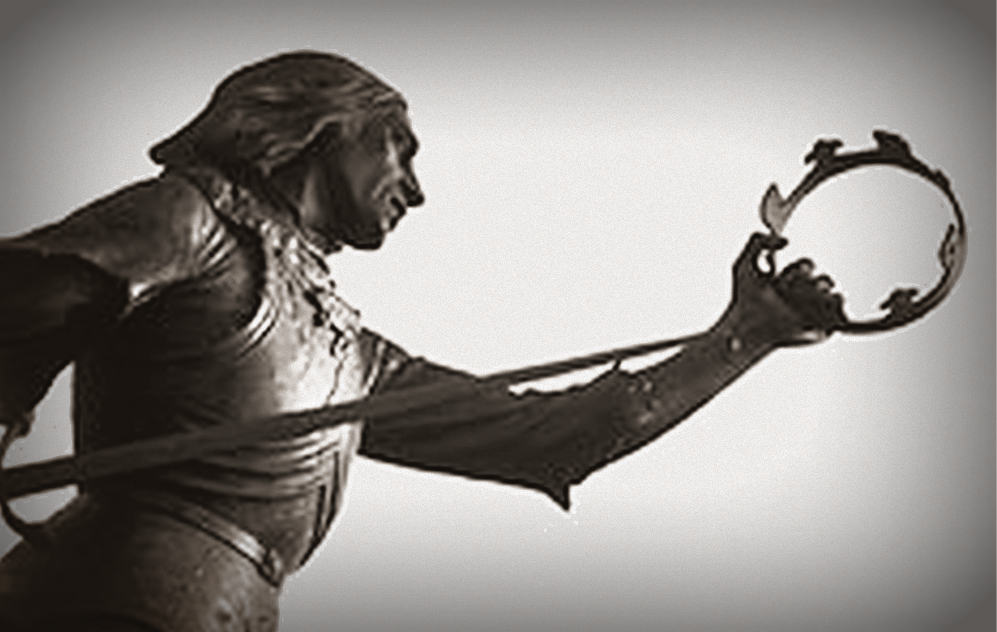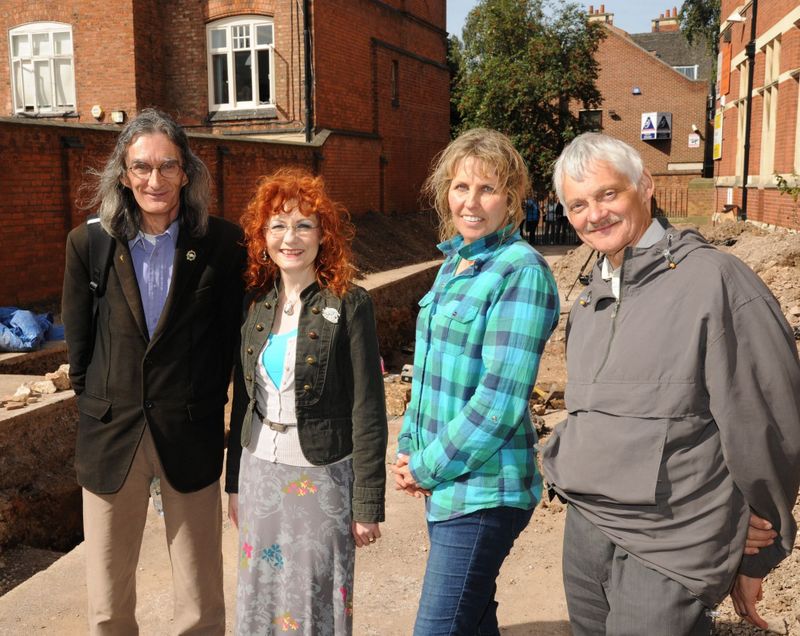
On the 25th of August, 1485, King Richard III was laid to rest in the Greyfriars Church in Leicester. Just over two years ago, on the 527th anniversary of his interment, the grave of Richard III was discovered. Today we are joined by the people at the heart of the incredible discovery, Looking for Richard members Annette Carson, Dr. John Ashdown-Hill , Dr. David and Wendy Johnson and Philippa Langley, to discuss their journey and what the future holds for King Richard III.
What first sparked your interest in Richard III’s life and what has he come to mean to you?
Annette Carson: My interest is not so much in Richard III’s life or biography, but more the political analysis of what happened and why. What attracted me was the extreme polarization of the two views of Richard. In our world where so much is measured, quantified, categorized and neatly labelled, I found it refreshing – and intellectually stimulating – to examine a genuine paradox and write books and articles about it, bringing with me a willingness to question everything. For years now I have lived and breathed the 15th century, that most complex and challenging of historical eras. Charles Darwin wrote, ‘Ignorance breeds more confidence than does knowledge’, and that sums up what Richard III has come to mean to me. There is just so much to learn.
John Ashdown-Hill: I was intrigued by the use of the word ‘usurper’ to describe someone who was offered the crown by Parliament. Incidentally, you can still find Richard III described as a ‘usurper’ today on the official website of the British Monarchy!!! I thought – and think – that this is amazing. No-one calls Edward IV and Henry VII ‘usurpers’, despite the fact that both of them seized the throne in battle. So my interest in Richard III was – and is – that there should be a level playing field. I don’t say he was a saint, or all white, but why should he be treated as a monster, and all black? It doesn’t make any sense.
David Johnson: I was ‘introduced’ to Richard III in 1993 by a friend from Atherstone who had been interested in Richard since childhood. Almost instantly I felt compelled to discover as much as I possibly could and Richard quickly became an abiding passion. I was struck by a profound sense of injustice. It seemed clear to me that Richard was a good man who took his responsibilities very seriously and always did his best in extraordinarily difficult circumstances. In fact Richard’s best appeared so markedly superior to that of his contemporaries that the crimes attributed to him and the accusations made against him seemed virtually impossible to believe. I think there’s a real sense in which the case of Richard III has become a metaphor for the need to challenge lazily accepted narratives of the past. For me at least, Richard III has become synonymous with the search for truth and justice.
Wendy Johnson: I grew up on the border of Yorkshire and County Durham and it was fascinating to discover that a king of England once spent much of his life in the area. On my first visit to Middleham Castle, my Dad bought a copy of the Pitkin Guide to Richard III, which has the famous NPG portrait of the king on the cover. I found the face in the portrait intriguing and, much like Inspector Grant in The Daughter of Time, I concluded that this was not the face of a villain. As an adolescent, I devoured any book I could find about his life and times, and it soon became clear to me that a good man had been very much maligned. What does Richard mean to me? I think he was the most enlightened king England ever had – that he wasn’t allowed the chance to prove it is one of the great tragedies of history.
Philippa Langley: I read Paul Murray Kendall’s biography in 1998. Using the historic sources, Kendall depicts a man who is loyal, brave, pious and just. I was intrigued. How did this fit with the villain of Shakespeare and the Tudor writers? My interest in Richard III has come to mean so much to me not only because it raises so many questions about the writing of history by the victors but about how careful we need to be when researching it. So many myths in Richard’s story had, over time, become truths – historical truths; such as the body in the river story.
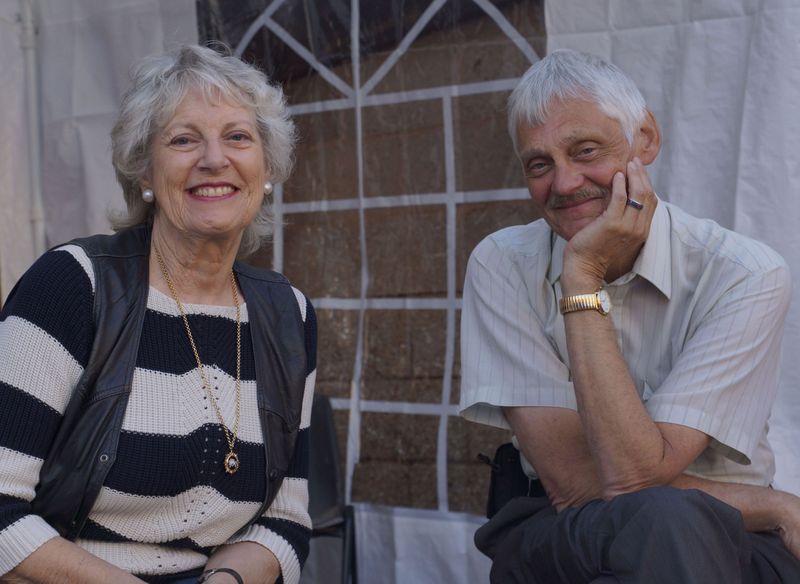
Your book Finding Richard III details research by Ricardians and historians who were convinced Richard still lay where he was first buried. Did you think that you would see his grave discovered in your lifetime?
Annette Carson: Frankly, no. I knew suggestions of an archaeological search in Leicester had been proposed over the years and been either ignored or dismissed. Respected historians like Charles Ross had decreed that Richard III’s remains were dug up and thrown into the river, something believed by 99 percent of people in Leicester. Ricardians who thought searching for his grave to be a worthwhile exercise were widely considered to be crackpots; some still believe this, or affect to believe it because it sounds clever and amusing. So there’s always been a huge mountain to climb, and a lot of personal credibility at risk for anyone who engaged in such a project.
John Ashdown-Hill: I wasn’t sure. It was such an uphill struggle. In Leicester, there seemed to be absolutely no interest in doing a dig, and of course initially we had no money to pay for one, which was why Philippa and I first decided to approach the TV programme Time Team, and why I wrote to them in 2005. But they decided they couldn’t take it on. Later, in 2009, after the formal foundation of Looking For Richard, Philippa asked me to write to ULAS, and I did, but they never replied.
David Johnson: From the launch of the Looking for Richard Project in February 2009 I was convinced we would find Richard, and if you don’t believe me ask Wendy and Philippa. That’s why Wendy and I began work on a tomb design in 2010 – two years before the archaeological search began. It seemed absolutely essential to have everything in place. Once the dig began we were convinced we were going to discover Richard’s lost grave.
Wendy Johnson: In the 1970s, Audrey Strange was the first to propose that Richard’s remains still lay undisturbed and I used to wonder why, given Audrey’s extensive research into the area of the Grey Friars, historians had never launched a search. To me, it was vital that the king, who had been denied a dignified burial in 1485, should be found and accorded the honour he deserved. I always hoped that this would happen in my lifetime – but I could never have imagined for one moment that I would become part of it.
Philippa Langley: The short answer is ‘no’. When I came to look at the research I always thought ‘someone’ will do this, but no one ever did. It was four years of research and a three and a half year battle in Leicester to cut the tarmac and convince others to come on board. For much of this time when we continually lost partners and funding it seemed that any search for the king’s grave was a hopeless cause.
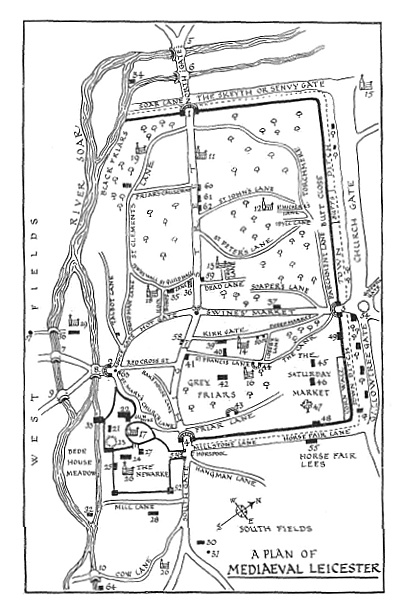
When did you decide that a search for his grave was possible?
Annette Carson: While I was living abroad and writing Richard III: The Maligned King I looked at all the evidence I could find and weighed up expert opinion. I concluded that the Social Services parking area was very probably where his grave lay, and said so in my book (published in 2008 but researched and written in 2002–5). This agreed with several Ricardian predecessors and with the Looking For Richard team. A search under this area of open tarmac was certainly desirable, and potentially possible. But being possible was never enough. It took Philippa’s hard work and sheer staying-power to open doors and make the search a reality.
John Ashdown-Hill: Philippa and I agreed on this in 2005. But I suppose both of us had decided independently a year or so earlier that it was worth doing.
David Johnson: John Ashdown-Hill’s presentation to the Scottish branch of the Richard III Society in February 2009 proved that a search was a viable proposition. John demonstrated that Richard’s remains lay where they were originally buried in 1485 and his discovery of Richard’s mtDNA provided the scientific breakthrough that would identify him. Without John’s historical and scientific research Richard would still lie beneath the tarmac of Leicester City Council’s Social Services car park.
Wendy Johnson: Having read John Ashdown-Hill’s The Last Days of Richard III, I was absolutely amazed that Richard’s DNA had been traced. This groundbreaking research meant that, if a search could be launched for the king’s remains, there would be a definite chance of identifying them.
Philippa Langley: It was 21 February 2009 when John and I finally met and I launched the Looking For Richard Project at the Cramond Inn in Edinburgh. We discovered that our research reached the same conclusion – the king’s body had not been dug up at the time of the dissolution and the likely location of the lost grave was in the northern end of the Social Services car park.
Regarding the enormous amount of work needed to prepare the proposal for the project and the fund-raising, how important was the support from the Ricardian community?
Annette Carson: You need to picture Philippa, a mother of two, working out of her home in Edinburgh. Piecing together enough evidence to convince herself, let alone the wider community of Ricardians who range from enthusiasts to prominent academics. This project was entirely speculative until most of the groundwork was actually set in place, which explains why she and her small team (which included the Johnsons from the start) toiled in isolation for several years. Only when most of the funding and permissions were in place did they feel confident enough to make it known to the Richard III Society membership at large, as late as 2011. But from that moment there was a groundswell of support. And of course the real outpouring came when we lost £10,000 in funding with only three weeks to spare – that was when we appealed directly to the individuals and branches and other Ricardian organisations, and the generosity and support were overwhelming.
John Ashdown-Hill: For me, actually, this is the most difficult question to answer. I had a great deal of support and interest from the Richard III Society members – and also from the Richard III Foundation, and other Ricardian groups – in my DNA research. But when I tried to interest the Richard III Society Committee in making the DNA research a Society project, I got no-where. And although some individual Richard III Society members kindly contributed funds to my work (which, of course, I had to finance myself) the Richard III Society gave me no official financial backing. And it was the same when it came to the dig. Without the wonderful financial support from Richard III Society members, the dig would not have taken place. But at the same time, significant members of the Richard III Society Committee were violently opposed to the archaeological project!
David Johnson: Without the financial support of the Ricardian community the dig would not have taken place – simple as that. Ricardians from all over the world saved the project with their amazing dedication and generosity. When a major funding partner pulled out at the eleventh hour there were only a few short weeks to raise the necessary cash. Nothing could happen until the archaeologists were paid in advance and in full. Philippa (with Annette’s help) launched an emergency international Ricardian appeal – and the rest, as you know, is history! Ricardian research and Ricardian money led to the discovery of Richard III.
Wendy Johnson: Essential. When the dig lost one of its financial backers, Ricardians worldwide were the ones who saved the project. If it hadn’t been for them, the excavation would never have gone ahead. The LFR project, and indeed the discovery of King Richard’s remains, owes everything to the king’s loyal supporters – without their overwhelming generosity it would never have gone ahead.
Philippa Langley: It was huge. Without their support and financial backing, the search for the lost grave of King Richard III would never have happened. They became the principal funding body, putting in 53% of the money required for the original 3 week dig project – which also allowed me to authorise exhumation of the remains in Trench One that the archaeologists weren’t interested in. I had £800 left from the Ricardian International Appeal and used this to pay for the exhumation of the remains that turned out to be those of the king.
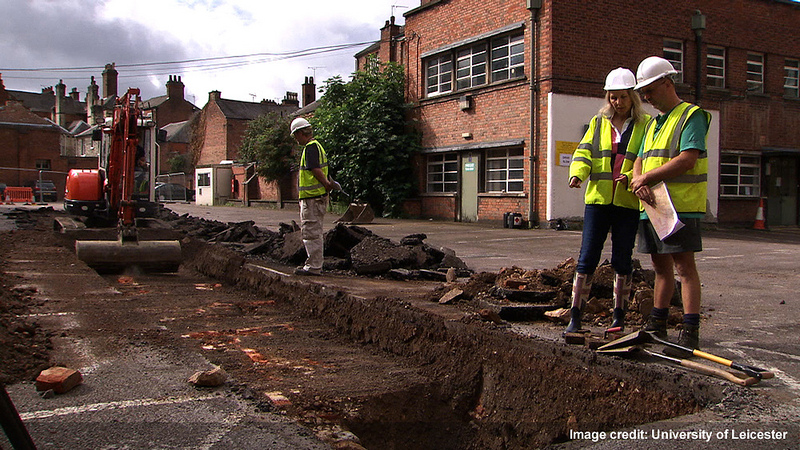
Did you think that the project would be successful?
Annette Carson: I had no doubt we would discover something of historical importance. I had complete faith in John Ashdown-Hill’s judgement as to the site of the Franciscan Priory Church, and I was sure Trench One would enable us to locate it. I also had implicit confidence in Philippa’s research, knowledge and leadership, and when she pointed to where she estimated Richard’s grave would lie, I took it as a serious likelihood. I felt that although we might not find him at the first attempt, whatever we did would set a ball rolling that would ensure further searches took place.
John Ashdown-Hill: I felt certain that we would find evidence of the Franciscan Priory and its layout. The leaders of ULAS didn’t seem very interested in the northern side of the site, and there was a bit of a battle to get them to dig there, but once the trench layout had been agreed I was also certain we would find the church. But I thought in the couple of weeks’ excavation Philippa had organised we might not hit the precise spot for Richard’s grave site, and that at the end of the dig we might have to sit down, look at the layout of the site that had emerged, and plan another dig for the following year!
David Johnson: I felt pretty certain we would find Richard, but whether or not the project has been a success is a slightly different question. Perhaps the most diplomatic thing to say is that everything was generally fine until Richard was discovered and identified. Once the University of Leicester took possession our carefully drafted agreements protecting the dignity of the remains were set aside and disregarded. As far as I am concerned this project was all about righting a wrong – providing Richard III with the honour and decency he was denied in 1485. So when it became clear that there might be a legal alternative to burial in Leicester, Wendy and I did everything we could to assist the Plantagenet Alliance and the campaign for York. Perversely enough, I remain optimistic that Leicester may not turn out to be Richard’s final resting place. The remains of Richard’s father and eldest brother were translated fifteen years after their original burial, and Richard himself translated Henry VI thirteen years after his death. Should Richard’s will or other compelling evidence finally come to light, I anticipate a vociferous campaign to reinter Richard in accordance with his irrefutably stated wishes.
Wendy Johnson: Yes. We were confident that Richard’s grave lay under the social services car park, and John’s research had located pretty much the exact spot where the choir would have stood. We also knew that, thanks to John’s excellent work on the DNA of Richard’s family, we had the king’s mtDNA sequence, and would be able to identify any remains found on the site. However, I am disappointed with the outcome. Our wishes to uphold the honour and dignity of the remains have been largely set aside: for example, our original agreements with the authorities in Leicester stipulated that there would be no photography of the bones. I have been horrified by the media exposure of the remains, and feel that the original ethos of the project has been disregarded.
Philippa Langley: It sounds strange to say, but yes. I thought that we would find him. It was this belief that drove me for seven and a half years.
So after all of this work you actually found Richard within the first few hours of the dig, were you confident that the grave was his despite not having the official confirmation?
Annette Carson: Confident is too strong a word for what I felt when the first leg bones were initially unearthed. I was certainly very excited! It was when I realized they were not only in the right place, but also at a depth that was roughly appropriate, and that no other burials were found nearby, that was when I began to feel quietly very confident. The battle trauma clinched it.
John Ashdown-Hill: Yes.
David Johnson: Yes – the remains were discovered in the location indicated by John Ashdown-Hill’s research, so I was in no doubt we had found Richard. When I first saw Richard Buckley’s archaeological plan I was delighted as the proposed line of trench one cut straight across the area we were interested in. When Stratascan Limited conducted a Ground Penetrating Radar survey of the Social Services car park in August 2011, I specifically asked Claire Graham to ensure that the northern end of the site close to the wall (where Richard was subsequently discovered) was thoroughly scanned.
Wendy Johnson: I had always thought that if Richard’s remains were discovered, the wounds alone would be enough to rule out any other possible candidates. Philippa had researched all known burials in the choir of the friary church since its foundation and this work was confirmed by John. Of the eight documented burials, it suggested that six were from the thirteenth century and one from the fourteenth century; these were all former benefactors of the friary, one of whom was a woman. The only remaining documented burial to have taken place in the choir in the fifteenth century was that of Richard III, in 1485.
Philippa Langley: Strangely, yes as the four years of research backed it up.
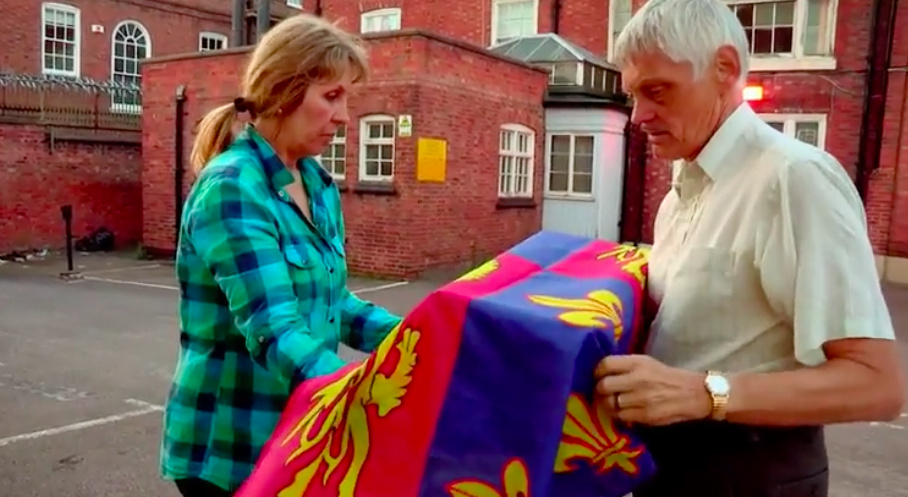
What was it like having to wait for weeks and weeks for the scientific testing to be completed?
Annette Carson: After the convincing evidence of the exhumation, the scientific tests promised few surprises. Regrettably, during those crucial five months we were prevented from sharing our knowledge as historians and researchers with the rest of the world. I now believe this to have been a mistake, because it created the impression that we had nothing to say about the search, nothing to contribute to the ID process. In fact the opposite was the case, as can be seen in our new book: with our extensive background research there was much we could have discussed and explained about our project, its subject, his characteristics and injuries, how John found his DNA, and how his remains were assumed lost until we made the effort to find them. Our enforced silence made it easy to diminish our role.
John Ashdown-Hill: Well actually it was unimaginable. Because we were supposed to be part of the ‘team’, and without us the body would never have been found, but we knew no more of what was going on than the world at large!
David Johnson: It was slightly frustrating because the whole process took much longer than we expected. However, I was always confident good quality DNA would be extracted and that John Ashdown-Hill’s meticulous genealogical research would be scientifically vindicated.
Wendy Johnson: As a natural pessimist I was concerned that any DNA may have degenerated over time and would prove difficult to extract, or to work with. Initially, we had not expected the DNA analysis to take any longer than a month or two and waiting until the New Year seemed like an age. Philippa was only informed of the result on the night prior to the official announcement, and was sworn to secrecy by the TV production company until this announcement had been made. So like everyone else, I was glued to the TV on the morning of 4th February 2013.
Philippa Langley: This was a really difficult time. I’d been asked by the TV production company not to have any contact with the University during the time of the identification work so that reactions to their scientific analysis would be candid. I was utterly exhausted so didn’t foresee any issues but, in hindsight, it was a mistake as our lead role in the historical research that got us to the car park was removed (hence why we have now written the Official Account). Waiting for the identification result was a roller-coaster ride because any one of the innumerable tests carried out by the specialists could have gone against identification, or been inconclusive. It was also deeply disappointing and distressing to discover that John had been barred from attending the University’s announcement (and the onscreen announcement the day before at the University). Without John’s research and discovery of the king’s mt DNA, the search for the king’s grave would never have happened. His was the ‘ground-breaking’ discovery.
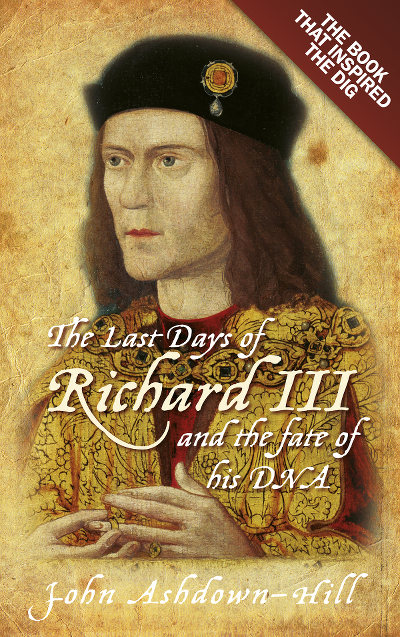
So how did you feel when it was finally confirmed that you had found Richard III?
Annette Carson: Being confident of his identity already, my interest at that point lay in the facial reconstruction which was due to be unveiled the following day, based on Richard’s own mortal remains. Professor Caroline Wilkinson and her team produced marvellous work.
John Ashdown-Hill: From my answers to the last two questions, perhaps you can imagine how I felt. I had believed from the day the leg bones were found that it probably was Richard, but in spite of being the person responsible for the discovery of Richard III’s mtDNA sequence, I hadn’t been kept up to date regarding the research which confirmed his identity, and although originally I was invited to the private announcement of the DNA results on Sunday 3 March 2013, I was then excluded from that event. So actually I felt very deeply hurt, and very puzzled about the way I was being treated.
David Johnson: I was very happy as you might expect. But because I had been so closely involved for such a long time, and because I expected to find Richard, it was more a sense of quiet satisfaction at a job well done. I was also very conscious that the difficult period we had carefully planned for – treating Richard’s remains with dignity and respect during the interval between discovery and re-interment – was now upon us. Having said that, I don’t think any of us anticipated what happened next.
Wendy Johnson: I have admired Richard since my school days, so it was quite a moment! I think that when you are so deeply involved in something, your field of vision narrows to encompass the work in hand. Only when you step back does the enormity of the achievement become apparent. My concern now is to blast away the rest of the Tudor myths.
Philippa Langley: It was a euphoric moment, but also worrying. I had agreements in place locally requiring respect for the religious beliefs of the (pre-reformation) king and to ensure that immediately following identification he would be honoured properly, but I was already getting a sense that vital clauses within my agreements were being put aside.
Do you think the general public perception towards Richard has changed over the last two years?
Annette Carson: The caricature is quickly disappearing and a real person emerging. Establishment figures are scared of dropping the old mask of disapproval, and the media still cling to storylines which used to sell newsprint, but they’ll catch up in time. By contrast, the public we’ve met at numerous events are all fascinated to discover aspects of Richard III that never normally came up for discussion. This can also be seen in the widespread reaction to arguments as to his place of reburial, and how his remains ought to be respected and commemorated. People are seriously interested in these debates.
John Ashdown-Hill: Oh yes – but not always in the right way. In fact my ongoing anxiety about the persistence of Ricardian mythology – both the traditional mythology and the modern inventions! – is behind my latest book, The Mythology of Richard III, due out next spring.
David Johnson: I think there is an encouraging groundswell of public opinion that no longer believes the Shakespearean caricature or the worst of the Tudor propaganda. Philippa explained how positive the reaction has been to her numerous talks. At a recent event in Edinburgh, before a sell-out audience of 500, there wasn’t a single question or comment condemning Richard. On the contrary, most people were keen to subscribe to the idea that Richard was a good man unjustly maligned.
Wendy Johnson: I would say it is changing. There is still a long way to go. Some historians, who were brought up on the Tudor myths, find it difficult to disown their long held beliefs – many have written much on Richard III, which does little but propagate the old stories. Things move slowly in academia and it is unfortunate that Shakespeare’s villain can still shape the public perception of Richard, but I think that in recent times (and especially since his discovery) many of the myths are being questioned. The fact that we have found Richard’s remains is only the beginning; it is now time for his character to be re-assessed in the light of renewed interest. I believe that, in time, Richard will be vindicated.
Philippa Langley: Yes. There has been a monumental shift. In the talks that I do up and down the country, it is clear that Richard is no longer viewed as the Tudor / Shakespearean caricature. The debate about his reputation is also no longer a minority group interest and the public are now finding out about the real Richard III for themselves.
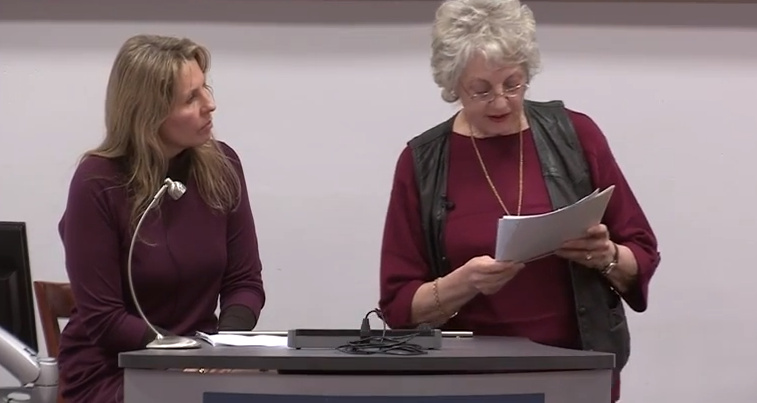
What would be your ideal outcome in regards to how the renewed interest in his life will affect Richard’s reputation?
Annette Carson: I hope his reputation will continue to be discussed, in a spirit of informed and respectful give and take. My wish list would be an end to attacks, defences, simplistic generalisations, and potted psychobabble. I’d love to wave a wand and create a moratorium on any biographies or other assessments of Richard III except when justified by some new insights which the writer has personally researched and formulated! We need to see courageous new theories, right or wrong, not endless rehashing of the same old ideas and discredited sources.
John Ashdown-Hill: Actually I’d really like people to accept that Richard III was a normal human being. In the end he was a defeated political leader, and like all defeated political leaders, he was then rubbished by those who defeated him. But to get at the real man you have to forget all that, and try to look at him without hindsight. That’s what I did in The Last Days of Richard III, when I stressed that Richard never heard of the battle of Bosworth, so he certainly didn’t spent the last five or six months of his life worrying about it. He just got on with the government and with his plans for the future, including his second marriage to Joana of Portugal, which of course never came to fruition, but which he thought was going to be the basis for the future of his dynasty. Unfortunately most historians – and as a result, also most other people – seem to find it really hard to avoid hindsight, and to try to look at things the way they seemed to the people of the day.
David Johnson: My personal hope has always been that the discovery of Richard III would inspire a new generation of young university based historians to re-evaluate the existing evidence and make a determined effort to scour the archives, both here and abroad, for new material. I’m convinced that much is yet to be discovered and that it can only have positive impact on Richard’s reputation.
Wendy Johnson: The discovery of Richard’s remains has successfully exploded at least three long held myths. Prior to the dig, most historians believed that his bones were dug up and thrown into the River Soar at the Reformation: we now know this to be false. Thomas More and Shakespeare called Richard a hunchback and gave him a withered arm: we now know Richard did not have kyphosis and his arms were identical. There are many more wrongs to be righted, but if historians were to discard the negative influence of Shakespeare and the Tudors, I believe the real man would begin to emerge. Only then, would I feel the search for the lost grave of Richard III had truly been a success.
Philippa Langley: I think we’re already seeing it. Discussion on Richard is around him as the medieval king, the warrior king; the last English king to die in battle. The Shakespearean anti-hero is no more. The recent TV programme on Richard was still trying to be sensationalist by trying to add new shortcomings like gluttony and being ‘dissolute’, but these are not supported by the contemporary evidence and people are now aware of distortions like this. I think this is the biggest change. We are now so highly attuned that spin on Richard in all its forms is no longer hidden – the public can now recognise it. We can only hope that TV decides to undertake cogent, researched programmes on Richard III in the future – and ditches the need for sensationalism.
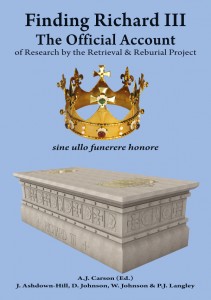 Visit the Looking for Richard Website and find out more in Finding Richard III: The Official Account. You can order your copy from:
Visit the Looking for Richard Website and find out more in Finding Richard III: The Official Account. You can order your copy from:
UK Residents from Annette Carson’s website. Click here to order.
Rest of the World from the Richard III Society shop.
Finding Richard III: The Official Account of Research by the Retrieval and Reburial Project
A.J. Carson (Ed.), J. Ashdown-Hill, D. Johnson, W. Johnson & P.J. Langley
Published by Imprimis Imprimatur ISBN 978-0-9576840-2-7
96 pages; 22 figs, maps, diagrams; 7 appendices including 22 pages of original documents and papers; bibliography; index; preface by Dr C.C. Thornton, FSA, FRHistS
A freelance historian; historicalresearcher; writer and lecturer; theleader of genealogical research and historical adviser on the ‘LOOKING FOR RICHARD’ project, which led to the rediscovery of the remains of Richard III in August 2012. His first degree was in history and French, followed by an MA in linguistics, and ultimately by a PhD in history, centred upon the client network of John Howard Duke of Norfolk in North Essex and South Suffolk. Since 1997 he has regularly given historical talks, and published historical research, achieving a certain reputation in aspects of late mediaeval history. His publications include six books, five of which are focused on the late Middle Ages. He has participated in British, Continental and Canadian documentaries on the search for Richard III, a general historical documentary on the life of Richard III for the USA and a forthcoming Channel 4 documentary on the fate of the ‘Princes in the Tower’.
Annette Carson
Having originally studied at the Royal College of Music, her career included working as a TV Organiser for British Equity, Programme Manager for Thames TV, and in PR and advertising as an award-winning copywriter. A freelance author with a preference for history and biography, she has sold over 46,000 non-fiction books on subjects including aviation and music, writes articles and has contributed to Encyclopædia Britannica. Her history of aerobatics was awarded the Tissandier Diploma of the Fédération Aéronautique Internationale. With a lifelong interest in Richard III, in 2008 she published Richard III: The Maligned King which led Philippa Langley to invite her to join the ‘LOOKING FOR RICHARD’ project as a historical consultant. In 2013 she published a short paperback (and eBook), Richard III: A Small Guide to the Great Debate, aimed at explaining the controversy to the general reader.
David Johnson BA Hons, MA, PhD
Wendy Johnson
Dr David and Wendy Johnson are long standing members of the Richard III Society and frequent contributors to the Society’s quarterly journal the Ricardian Bulletin. David, whose PhD in history was awarded by the University of York in 2013, is the author of Adwalton Moor 1643: The Battle That Changed A War (Blackthorn Press, 2003), and Wendy has sold and exhibited portraits of people and animals. David is preparing a new study exploring the political controversy surrounding Richard III’s accession to the throne, whilst Wendy is currently researching a proposed trilogy based on the Wars of the Roses.
Philippa Langley
A screenwriter and producer, Philippa Langley inaugurated the ‘LOOKING FOR RICHARD’ project and led the successful search to locate King Richard III’s grave. She is a TAPS writer, a BAFTA Rocliffe shortlisted writer, and finalist in SWF’s Scriptmarket and Channel 4’s ‘Son of the Pitch’ competition. Her 90 minute documentary, The King in the Car Park, made with Channel 4 and Darlow Smithson Productions, was Channel 4’s highest rated specialist factual show, going on to win the Royal Television Society Award for 2013 and a BAFTA nomination in 2014. Her screenplay Richard III: Last of the Warrior Kings on the life of Richard III is based on Bosworth 1485: Psychology of a Battle by military historian Michael Jones, with whom she co-authored The King’s Grave: The Search for Richard III in 2013. Founder of the Richard III Society’s Scottish Branch, she is a regular contributor to the Ricardian Bulletin magazine and was awarded the Society’s Robert Hamblin Award in 2012.

